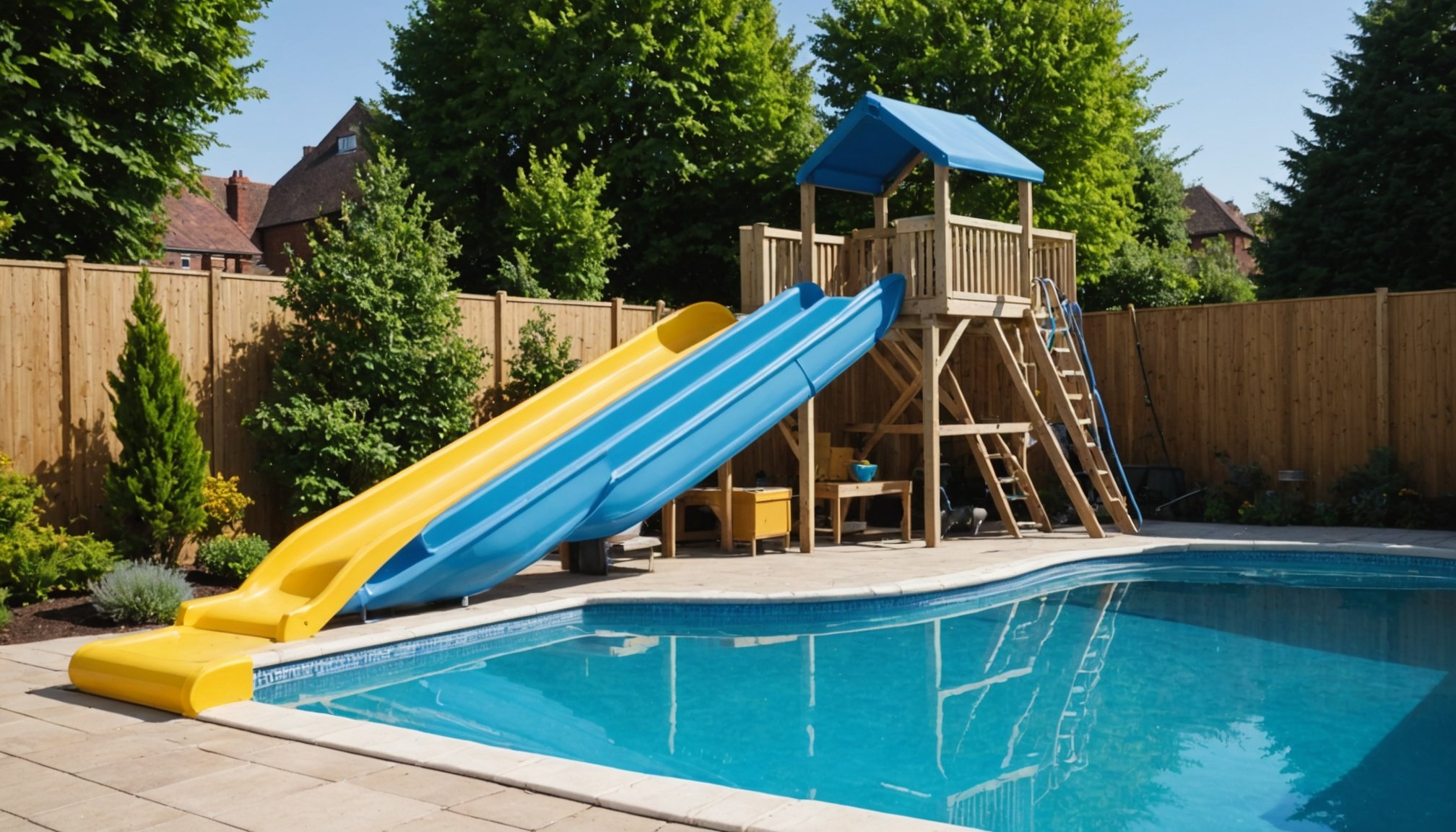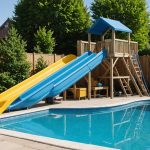Understanding UK Safety Standards for Pool Slides
Navigating the labyrinth of UK safety standards and pool slide regulations can be daunting, but it’s crucial for ensuring both enjoyment and safety. These legal requirements are designed to protect users by minimizing risks associated with pool slides.
In the UK, pool slide regulations are stipulated by specific health and safety laws. Compliance with these regulations is vital for reducing accidents and ensuring a safe environment. Regulations cover aspects such as slide design, materials used, and installation processes. For example, there might be requirements for the slipperiness of the slide material or its structural integrity to bear certain weights.
Sujet a lire : Transform Your UK Home: Creative Tips for Designing a Stunning and Functional Pool Area
Non-compliance isn’t just a risk to safety — it can also lead to severe penalties. Businesses or individuals failing to adhere to these legal requirements may face fines or even legal action. This underlines the importance of implementing and adhering to these standards, not just for legal reasons but to uphold ethical responsibility towards user safety.
To effectively ensure compliance, it may be beneficial to consult with safety experts or legal professionals familiar with these regulations. This proactive approach aids in safeguarding against potential pitfalls and promotes a safer recreational environment. Understanding and upholding these standards is essential for those involved in the design and installation of pool slides.
Cela peut vous intéresser : Ultimate baby floats and armbands for safe water fun
Legal Requirements for Pool Slide Installation
Installing a pool slide comes with a set of legal obligations that ensure safety and compliance. Firstly, obtaining the necessary permits and approvals is crucial. These are often mandated by local building codes and zoning laws, which vary depending on your location. Installation laws require thorough inspections by professionals. Thus, it’s advisable to contact your local government office to identify the specific permits needed.
Understanding the role of local authorities is essential. They ensure that the installation adheres to specific standards, thereby minimizing accidents and liabilities. Local authorities typically review the site plan and assess the structural integrity of the slide. Furthermore, they verify that the slide’s design complies with statutory requirements and safety standards outlined by the government. Cooperation with these authorities is not only a legal requirement but also a means to ensure the safety of users.
Several essential legal documents are required throughout the installation process. These may include property deeds, proof of insurance, and contractor agreements. These documents help establish the legitimacy and compliance of your installation project. Ensure that all submissions are accurate and up-to-date to avoid potential legal disputes. By adhering to these legal requirements, you can enjoy peace of mind knowing your pool slide is both fun and safe.
Best Practices for Installing Pool Slides
When considering installation best practices for pool slides, prioritising safety and longevity is crucial. The key is to ensure secure installation through recommended techniques. First, begin with a solid base; use concrete or another sturdy material to provide firm support for your slide. This foundation is essential in preventing shifts that could lead to accidents.
Choosing certified materials during installation cannot be overemphasised. Certified materials ensure durability and compliance with safety standards. Corrosion-resistant metals and UV-resistant plastics are excellent choices as they withstand environmental exposure while maintaining structural integrity over time.
Incorporating significant safety features is a vital component of the installation process. Consider installing non-slip steps and handrails. These features reduce the risk of slips and falls, particularly in wet conditions. Also, ensure the slide exits into deep enough water to accommodate the expected speed and weight of users safely.
Installation techniques also recommend following manufacturer guidelines rigorously. They provide specific instructions tailored to the slide model, ensuring optimal performance and safety. Hire professionals if needed, especially for complex installations, to guarantee all safety protocols and guidelines are adhered to.
Ultimately, meticulous attention to these details enhances user safety and prolongs the longevity of your pool slide, yielding peace of mind and endless enjoyment.
Essential Safety Features and Specifications
Ensuring the safety features of a pool slide are in line with UK standards is paramount. Key elements include safety rails and anti-slip surfaces, both essential to mitigate risks of slipping and falling. Confirm that the materials used in the slide’s construction are robust and non-toxic, like UV-stabilised polyethylene, which not only ensures durability but also enhances user safety by reducing exposure to harmful chemicals.
When discussing pool slide specifications, the angle and height are critical considerations. According to experts, an ideal slide angle should be less than 30 degrees to ensure a thrilling yet safe descent. The maximum recommended height is generally around 2 meters, especially for home use, to prevent accidents while maintaining an enjoyable experience.
It’s crucial to implement effective risk mitigation strategies. Regular maintenance checks for damage or wear and tear can help address potential safety hazards promptly. Children should always slide in a seated position with arms and legs inside the slide to avoid injuries. Additionally, installing a water flow regulator can control the slide’s speed, providing a safer environment for younger users.
By adhering to these guidelines, you can significantly reduce potential risks while maximising the enjoyment of your pool slide.
Maintenance and Safety Checks Post-Installation
Ensuring the longevity and safety of your pool slide involves regular maintenance checks and safety inspections. Performing these assessments allows for the timely detection of wear and tear, extending the life of the installation and ensuring user safety.
Regular maintenance tasks for pool slides include cleaning the slide surface to prevent the buildup of dirt and algae, which can cause surfaces to become slippery and hazardous. Also, check for water leaks in the slide structure, which might lead to damage over time. Greasing moving parts, such as joints and couplings, ensures smooth operation and minimizes noise.
Conducting safety inspections is crucial in identifying potential hazards. These inspections should include assessing the structural integrity of the slide, checking for cracks, and ensuring all fasteners and supports are secure. Look for any sharp edges or protrusions that could cause injury and remove them immediately.
For a thorough review, consider the following checklist for safety feature evaluations:
- Ensure the slide has sufficient handrails and barriers.
- Confirm that there are non-slip surfaces on steps and platforms.
- Test the water flow to avoid inadequate water coverage.
- Verify that warning labels are visible and legible.
Implementing these evaluations and maintenance checks will enhance the safety and enjoyment of your pool slide.
Common Pitfalls to Avoid
When embarking on the installation of a pool slide, avoiding installation mistakes is crucial to not only ensure the satisfaction of the project but also to guarantee safety for all users. One frequent error is improper alignment during the installation process which can lead to serious operational issues. Similarly, neglecting manufacturer guidelines can result in compliance pitfalls, ultimately affecting the slide’s integrity.
Safety oversights can have dire consequences, ranging from minor injuries to serious accidents. Not adhering to safety standards can also result in costly fines or necessitate entire project overhauls. Thus, it’s important that during and after installation, thorough compliance with set safety regulations and guidelines is maintained.
To avoid such pitfalls, consider the following tips:
- Ensure that installation instructions from the manufacturer are followed meticulously.
- Regularly check and confirm that all components are securely fastened during installation.
- Conduct a final inspection to ensure that all safety features are correctly implemented.
By taking these considerations into account, you will set a solid foundation, improving both the enjoyment and safety of your pool slide experience.
Resources for Pool Slide Safety Compliance
Ensuring pool slide safety compliance involves utilising various resources focused on maintaining and implementing proper safety standards. In the United Kingdom, there are government resources providing essential safety guidelines for pool slide installation. The Health and Safety Executive (HSE) offers comprehensive regulations and advice to support safety compliance. Their informative links guide installers in adhering to national safety requirements accurately and efficiently.
In addition to governmental support, several associations and organizations play active roles in endorsing UK compliance. The Royal Society for the Prevention of Accidents (RoSPA) and the British Swimming Pool Federation (BSPF) offer indispensable compliance resources. They provide valuable insights, ensuring pool slide safety is prioritized.
For installers, useful checklists and guides are crucial. These practical tools support the detailed work involved, offering step-by-step guidance to meet safety standards. Installers are encouraged to utilize professionally crafted checklists that outline the critical steps for achieving compliance. These resources reduce the risk of overlooking vital safety details, thereby enhancing overall safety.
Harnessing these resources equips installers and pool owners with the necessary knowledge and tools to ensure their pool slides are safe and compliant, promoting a secure and reliable environment for everyone involved.











